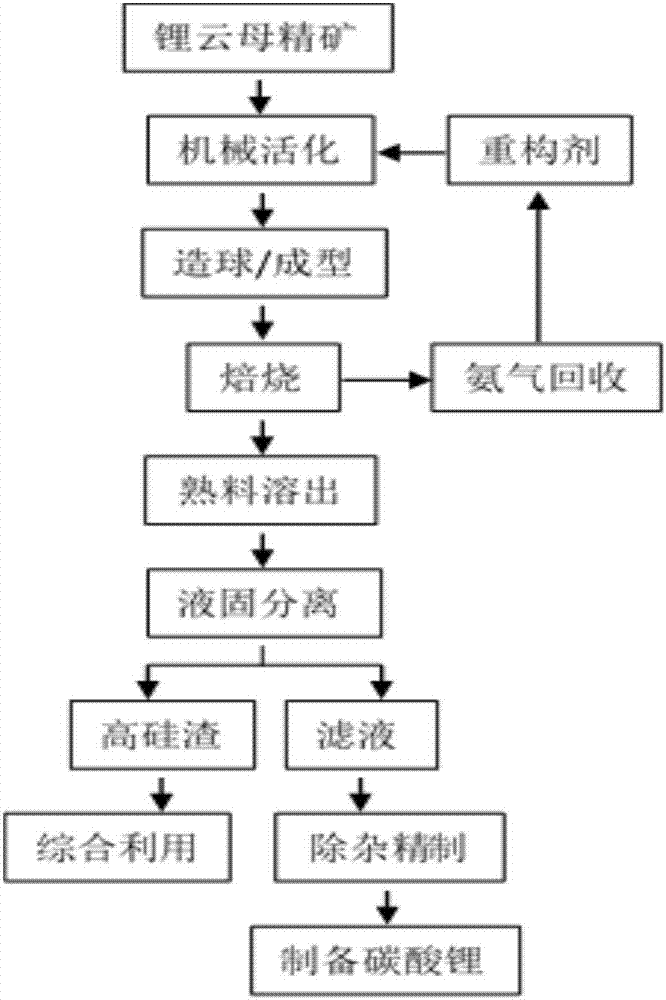Method for extracting metallic elements by treating lepidolite
A technology of metal elements and lepidolite, which is applied in the processing of mineral raw materials and in the field of extracting metal elements from lepidolite, can solve the problems of insufficient defluorination, insufficient mechanical activation, high pressure cooking temperature, etc., achieve high recovery rate and solve separation difficulties , Enhance the effect of reactivity
- Summary
- Abstract
- Description
- Claims
- Application Information
AI Technical Summary
Problems solved by technology
Method used
Image
Examples
Embodiment 1
[0039] Ball mill lepidolite concentrate to below 100 mesh, take mechanically activated mica ore, ammonium sulfate, and methyl cellulose in a mass ratio of 1:1.2:0.2, and react at 220°C for 90 minutes, and then at a speed of 20°C / min Heat up to 400°C for 20 minutes, then cool to obtain clinker. During the roasting process, waste gas is recovered to prepare ammonium salts and returned to the reconstitution batching process. The waste heat is used to dry lepidolite. The obtained clinker was reacted at 10°C and a liquid-solid ratio of 2:1 for 30 minutes, filtered to preferentially separate the lithium salt solution, and the filter residue was reacted at 96°C and a liquid-solid ratio of 2:1 for 60 minutes, and filtered to obtain sodium, potassium, rubidium, and cesium , aluminum solution, and the secondary leaching filter residue is washed countercurrently with hot water at 90°C.
[0040] The extraction rate of lithium, sodium, potassium, rubidium, and cesium after mineral phase re...
Embodiment 2
[0042] Ball mill the lepidolite concentrate to below 200 mesh, take the mechanically activated mica ore, ammonium sulfate, and methyl cellulose in a mass ratio of 1:1.2:0.2, and react at 250°C for 75min, then at 20°C / min Heat up to 480°C for 30 minutes, then cool to obtain clinker. During the roasting process, waste gas is recovered to prepare ammonium salts and returned to the reconstitution batching process. The waste heat is used to dry lepidolite. The obtained clinker was reacted at 15°C and a liquid-solid ratio of 1.8:1 for 30 minutes, filtered to preferentially separate the lithium salt solution, and the filter residue was reacted at 90°C and a liquid-solid ratio of 2:1 for 60 minutes, and filtered to obtain sodium, potassium, rubidium, and cesium , aluminum solution, and the secondary leaching filter residue is washed countercurrently with hot water at 90°C.
[0043] The extraction rate of lithium, sodium, potassium, rubidium and cesium after mineral phase reconstructio...
Embodiment 3
[0045] Ball mill the lepidolite concentrate to below 200 mesh, take the mechanically activated mica ore, ammonium sulfate, and methyl cellulose in a mass ratio of 1:1.2:0.2, and react at 300°C for 75 minutes, then at a speed of 20°C / min Heat up to 600°C for 30 minutes, then cool to obtain clinker. During the roasting process, waste gas is recovered to prepare ammonium salts and returned to the reconstitution batching process. The waste heat is used to dry lepidolite. The obtained clinker was reacted at 10°C and a liquid-solid ratio of 2:1 for 30 minutes, filtered to preferentially separate the lithium salt solution, and the filter residue was reacted at 80°C and a liquid-solid ratio of 2:1 for 60 minutes, and filtered to obtain sodium, potassium, rubidium, and cesium , aluminum solution, and the secondary leaching filter residue is washed countercurrently with hot water at 90°C.
[0046] The extraction rate of lithium, sodium, potassium, rubidium and cesium after mineral phase...
PUM
 Login to View More
Login to View More Abstract
Description
Claims
Application Information
 Login to View More
Login to View More - R&D
- Intellectual Property
- Life Sciences
- Materials
- Tech Scout
- Unparalleled Data Quality
- Higher Quality Content
- 60% Fewer Hallucinations
Browse by: Latest US Patents, China's latest patents, Technical Efficacy Thesaurus, Application Domain, Technology Topic, Popular Technical Reports.
© 2025 PatSnap. All rights reserved.Legal|Privacy policy|Modern Slavery Act Transparency Statement|Sitemap|About US| Contact US: help@patsnap.com

